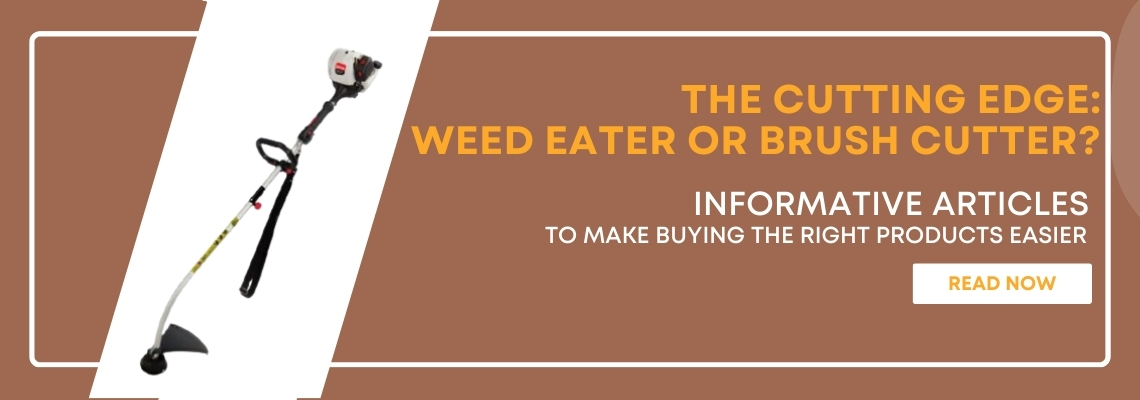The Cutting Edge | Weed Eater, or Brush Cutter?

The Cutting Edge: Weed Eater, or Brush Cutter?
In the world of lawn care and landscaping, the names used to
describe lawn tools can be a little confusing. Various terms like weed eater,
string trimmer, and brush cutter are regularly used interchangeably but are
they the same thing?
The origin and evolution of the Weed Eater
The weed eater originated in the 1970s when George Ballas,
invented the Weed Eater. This ingenious machine was marketed by the Weed Eater
brand, and revolutionised lawn care by offering a convenient solution for
trimming grass along edges. The saddest of all is that this was inspired by a
snake bite incident using pruning shears and Ballas crafted a makeshift device
using a tin can and wires, which eventually led to the development of the weed
eater.
While the original invention was dubbed the Weed Eater,
trademark issues and marketing strategies have led to other manufacturers to
use terms like string trimmer, weed whacker or brush cutter. These
terminologies can also vary based on geographical location, brand preferences
and even personal habits. So let us have a look at the differences between
these machines.
The Weed Eater
A Weed Eater, also known as a string trimmer, features a
rotating head with a nylon cutting line. It is designed for precision trimming
and edging tasks.
This machine is lightweight, manoeuvrable and suitable for
small-scale trimming but may struggle with tougher vegetation. It is best used
for precision trimming around your flowerbeds, sidewalks and areas that are
inaccessible to larger machines.
The Brush Cutter
The Brush Cutter is a powerful machine equipped with a metal
blade, ideal for tackling dense vegetation and woody plants. It is powerful,
versatile and durable but can also be heavy and noisy and slightly more
dangerous due to the metal blade. This machine is used for clearing large areas
of dense vegetation and can tackle tough overgrowth. It can even cut through
small trees and shrubs.
Optimal performance:
For the optimal machine, choose a curved or straight-shaft
design, based on your personal preference or comfort.
Most of these machines in South Africa are petrol-powered
and offer more power but these machines can be heavier and produce more
vibration and noise when compared to electric or battery-powered options.
The edge trimmer or brush cutter should be maintained
regularly to ensure longevity and efficiency. It needs to be cleaned and
greased after every use, as well as on the first use.
When you buy a petrol-powered edge trimmer or brush cutter,
you will need to ensure that you use the correct fuel mixtures as some come in
two-stroke or four-stroke engines and you will need to ensure the machine is
well-greased and lubricated before the first use. It is also advisable to check
the spark plug of the machine before using it for the first time. Some machines
are in transit for such an extended period that the spark plug starts to
deteriorate so it is advisable to have an extra on hand.
For more information on the fuel mixtures of two-stroke
machines, read our blog,
but your best bet is always to refer to the owner's manual that you receive
with your machine upon purchase.
At AgMarket we’re committed to providing valuable resources
and solutions for all your agricultural and lawn care needs. Whether you are a
homeowner looking to beautify your backyard or a professional landscaper
seeking top-quality equipment, we’ve got you covered. Below we have a brief
overview of the available edge trimmers on our online marketplace for your
convenience.
52cc
Tanaka Pro 52 Brush Cutter Heavy Duty Shaft
Husky
143R11 HD Brush Cutter 41.5cc
Husky
Pro 30 Bent Shaft Trimmer 26cc
LINE
TRIMMER, 26CC 4-STROKE WITH BENT SHAFT | RYOBI
ELECTRIC
LINE TRIMMER, 550W | RYOBI
AgMarket also offers a range of spare parts for these
machines as well as a selection of two-stroke oil, trimmer line and replacement
engines for these machines. Shop online today to purchase your Brush Cutter or
Wead Eater and get your purchase delivered straight to your door.

